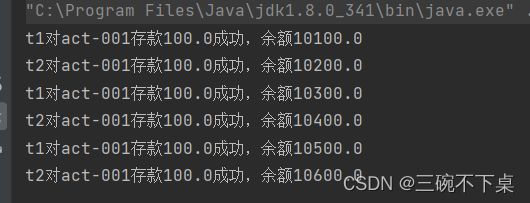采用多线程机制模拟汇款业务。定义一银行类可接受顾客的汇款,其属性count用于存储账户金额。现有两名顾客,每人分三次、每次100元将钱汇入count。每进行一次汇款,便输出汇款人和账户总额。
Account类:
package com.bjpowernode.java.threadsafe3;
public class Account {
// 账号
private String actno;
// 余额
private double balance;
public Account() {
}
public Account(String actno, double balance) {
this.actno = actno;
this.balance = balance;
}
public String getActno() {
return actno;
}
public void setActno(String actno) {
this.actno = actno;
}
public double getBalance() {
return balance;
}
public void setBalance(double balance) {
this.balance = balance;
}
public synchronized void save(double money){
double before = this.getBalance(); // 100
double after = before + money;
try {
Thread.sleep(1000);
} catch (InterruptedException e) {
e.printStackTrace();
}
this.setBalance(after);
}
//取款的方法
/*
在实例方法上可以使用synchronized吗?可以的。
synchronized出现在实例方法上,一定锁的是this。
没得挑。只能是this。不能是其他的对象了。
所以这种方式不灵活。
另外还有一个缺点:synchronized出现在实例方法上,
表示整个方法体都需要同步,可能会无故扩大同步的
范围,导致程序的执行效率降低。所以这种方式不常用。
synchronized使用在实例方法上有什么优点?
代码写的少了。节俭了。
如果共享的对象就是this,并且需要同步的代码块是整个方法体,
建议使用这种方式。
*/
public synchronized void withdraw(double money){
double before = this.getBalance(); // 10000
double after = before - money;
try {
Thread.sleep(1000);
} catch (InterruptedException e) {
e.printStackTrace();
}
this.setBalance(after);
}
}
AccountThread类:
package com.bjpowernode.java.threadsafe3;
public class AccountThread extends Thread {
// 两个线程必须共享同一个账户对象。
private Account act;
// 通过构造方法传递过来账户对象
public AccountThread(Account act) {
this.act = act;
}
public void run(){
// run方法的执行表示取款操作。
// 假设取款5000
double money = 100;
// 取款
// 多线程并发执行这个方法。
for (int i=0;i<3;i++){
act.save(money);
System.out.println(Thread.currentThread().getName() + "对"+act.getActno()+"存款"+money+"成功,余额" + act.getBalance());
}
}
}
Test类:
package com.bjpowernode.java.threadsafe3;
public class Test {
public static void main(String[] args) {
// 创建账户对象(只创建1个)
Account act = new Account("act-001", 10000);
// 创建两个线程
Thread t1 = new AccountThread(act);
Thread t2 = new AccountThread(act);
// 设置name
t1.setName("t1");
t2.setName("t2");
// 启动线程取款
t1.start();
t2.start();
}
}
实验运行截图:
